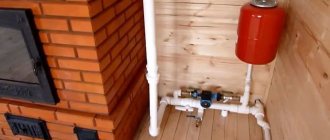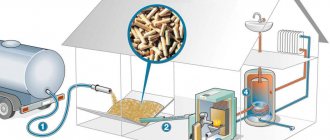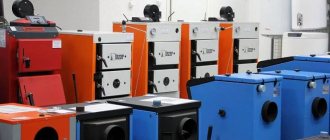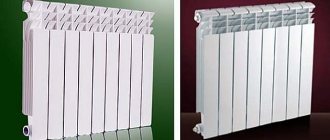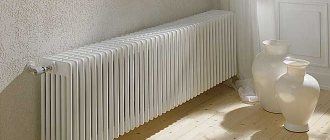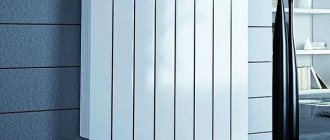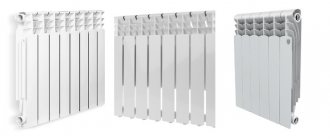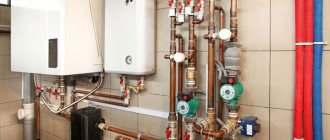The main reason why many doubt the idea of living at home in winter is doubts about its comfort and warmth. Plumbing and sewer systems, exterior and interior - all this is important, but if the home is cold, then it will not be possible to make it cozy.
The cornerstone in organizing a heating system is the selection of a radiator. It determines how comfortable the temperature in the room will be, as well as the durability and reliability of the entire heating system. Which radiators are best for heating a private home? Let's take a closer look at the features and characteristics of each type, but first you need to decide on the tasks and operating potential of the heating system.
Features of the heating system of a private house
Schematic illustration of an autonomous heating system
Selecting a battery model for a house, although not radically, differs from arranging a system in an apartment. Firstly, the heating system in summer cottages and villas is often created according to the owner’s own design based on the expected convenience. Secondly, even with “standard” options it has its own characteristics:
- The water supply is under slight pressure, so you can rely not only on the safety margin.
- Water hammer due to maintenance and failures is eliminated, increasing the range of suitable batteries for you.
- The coolant is most often of better quality than in a central heating system.
That is, in a private house you can install any model of heating radiators, focusing not on a large margin of safety, but on the heat transfer coefficient and cost. However, it is important to know how to choose heating radiators for a private home in order to purchase the optimal option in terms of cost and quality (combination of heat transfer, reliability and design aesthetics).
Today, the range of batteries is based on aluminum, cast iron, steel and bimetallic models. Each has features, advantages and disadvantages.
Principles for calculating battery power
To choose heating radiators for a country or private house, you need to perform calculations based on the fact that to heat one square meter. m of living space requires approximately 95–125 kW. To warm up a room with average parameters (one window, one door, ceiling height up to 3 meters), it is necessary to heat the coolant to 70 °C.
Article on the topic: How to replace the foundation under a wooden house
If actual parameters differ from those indicated, adjustments must be made. For example, with a ceiling height of more than 3 meters, it is necessary to increase the calculated power of the batteries as many times as the actual height exceeds the conditional one. For low ceilings, recalculation is carried out in the opposite direction.
A decrease in coolant temperature for every 10 °C relative to the specified average level forces a corresponding increase in the design power of heating devices by 15–20%. If the room is corner and has two windows, the average calculated power of the batteries is increased by 1.5 times.
The heat transfer of radiators largely depends on their connection diagram. The average calculation is based on the fact that the heated coolant is supplied to the upper side inlet, and the return is connected to the lower inlet diagonally. Other connection options are less efficient and reduce the heat dissipation of batteries by 5–10%.
Note! The number of sections for radiator models of this type should not exceed 10 pieces - further expansion will not help increase power, since the coolant will not be able to fully warm up such a battery.
Comparison of thermal power of different types of batteries
Calculating radiator parameters
Particular care should be taken when choosing panel and tubular batteries. Manufacturers include in their product line models of the same power, but with different geometric parameters. When choosing, take into account the features of the installation location - the height from the floor to the window sill, the length of the wall in an elongated room, etc.
Homeowners choosing heating devices and wanting to purchase the best options at a reasonable price opt for steel or aluminum models. The cost of the most reliable, imported bimetallic radiator is prohibitively high, and cast iron batteries have many serious disadvantages. According to statistics, those who are thinking about which radiators to choose for a private home or country house choose aluminum sectional or steel panel models based on the ratio of price and practicality.
Video with tips for choosing heating radiators:
Aluminum heating radiators for home
Aluminum radiator from Global
When considering heating radiators that are better for a private home, as well as the characteristics of the models, owners of country houses and villas are increasingly choosing aluminum ones. The popularity of aluminum batteries is due to their aesthetic design and high power.
If we talk about price, then batteries produced by Russian factories will cost less. However, if you carefully study the reviews and compare the characteristics, you will understand that it is worth making a choice in favor of foreign analogues. Although they are more expensive, they pay for themselves due to their durability.
When choosing, it is worth considering that the radiator is made of aluminum:
- Most sensitive to the quality of the coolant. If the acidity of the water is high and hard impurities are observed, then it will fail within a few years. If the coolant is of good quality, the radiator will last longer than 10 years without breakdowns.
- Has a threaded connection. This increases the risk of leakage, but simplifies installation and dismantling of the device.
- At high power, it creates a temperature difference between the bottom and the top. That is, when the battery is operating, warm air rises, so the heating is uneven. The problem can be solved either by purchasing a modern model that provides good air circulation, or by accurately calculating the area of the room and selecting a battery based on this parameter.
Aluminum battery in section
In addition to their features, aluminum batteries have advantages that influence the choice in their favor:
- Light weight and size, which allows them to be mounted on plasterboard walls, facilitates installation and dismantling, and transportation.
- Aesthetic design. Modern models do not have sharp corners, they are distinguished by elegant lines, designs, and classic shades.
- Possibility to install a temperature control tap.
- Low cost.
- Fast heating due to the high conductivity of the metal.
Compared to other radiators, aluminum ones are not very durable, but the price, however, the price and thermal characteristics make them popular. This is a good option for a summer house or villa, and if you choose wisely, you will not regret the purchase.
— Why not install cheaper wall convectors?
It would seem - indeed, because convectors do not require installation of a boiler, pipe routing, and so on. One-time costs are lower. At the same time, their energy consumption is similar to that of a system with an electric boiler. But we shouldn’t discount the following fact: if we install an electric boiler, the cable is connected to the boiler - and we get one potentially dangerous point. If we are talking about convectors, then the number of such connection points is equal to the number of convectors. That is, their operation requires very competent electrical wiring. All cables must be twisted very tightly, the cable must be copper, the twists must be insulated, and all this must be in fireproof casings.
Cast iron heating radiators
Cast iron radiators are an elegant solution for many types of interiors
When considering which radiators to choose for heating a private house, it is worth mentioning cast iron ones, although, looking ahead, this is not the best option. Cast iron was used in Soviet apartments; you can still find bulky batteries in old homes.
The advantages of cast iron include:
- High resistance to poor quality coolant. The material withstands even rusty water with sediment perfectly and does not enter into a chemical reaction with it.
- Long-term heat retention. In case of an emergency shutdown, cast iron retains heat for a long time. Residual heat retention varies within 30%, which is higher than other types of radiators.
- High mechanical strength.
- Long service life.
- Resistance to chemicals, including acids.
Note! Cast iron models are very heavy and cannot be mounted on plasterboard walls.
Modern stores can offer designer cast iron batteries. Although they retain disadvantages such as heavy weight and low heat transfer, they look aesthetically pleasing.
Bimetal heating radiators
Bimetallic batteries are made of two types of metal
The peculiarity of bimetallic battery models is the combination of two metals in the design. The basis of the frame is made up of tubes arranged vertically and horizontal steel collectors connected by an aluminum shell. The design is made by injection molding, the elements are connected by electric arc welding, and therefore is highly durable.
The advantages of bimetallic batteries are based on the high resistance of steel to corrosion and the thermal conductivity of aluminum, as well as their low weight. However, their cost is higher than that of other models, and it is difficult for people with average incomes to buy them.
Note! You can find cheap bimetallic radiators in stores, but in quality they are in any case inferior to similar priced aluminum and steel batteries.
It is not advisable to use bimetallic heating devices in a private home due to cost. In autonomous systems there are no water hammers or high pressure in the network, which reduces the need for a safety margin, and the coolant is of relatively good quality, so resistance to rust is practically useless.
Which pipe is better?
If you are interested in good material, then look towards metal-plastic pipes. They go in bays. All joints are often on the surface. Quite flexible. Holds angle and high temperatures.
Pipes made of cross-linked polyethylene are also good. But they are not designed for long-term use at high temperatures. But they have proven themselves excellent in low-temperature systems.
Copper pipes are excellent, but should be used sparingly. Basically, boiler rooms are made with such pipes.
Metal-plastic pipes will still be universal. Focus on them
Steel heating radiators
Picture of a steel panel heating radiator
Speaking about what types of heating radiators for home there are, which are better for an individual heating system, we must not forget about steel radiators, since this is the best option because they:
- They have compact sizes, which allows them to be placed in niches.
- They are distinguished by high heat transfer.
- They look aesthetically pleasing.
The main advantage of steel radiators is several variations of connection to the general heating system, depending on the type of battery. If your home has large windows, a panel type battery will help avoid drafts because it blocks cold air from the window. With excellent characteristics, steel radiators have an optimal price, which is excellent for a private area.
Picture of a steel tubular heating radiator
Note! Tubular radiators are slightly more expensive than panel and sectional ones, which is explained by their more elegant appearance and longer service life.
Tubular steel radiators are a common choice for families with children, as they are convenient for drying things. Steel radiators are also different:
- Resistant to oxidation, which increases their service life.
- Excellent thermal conductivity, thanks to which they quickly heat the room.
- Low weight and dimensions.
The disadvantages include vulnerability to corrosion, which makes their use in housing where the coolant contains a high percentage of oxygen impractical. Also, steel batteries should be washed every few years to prevent slagging of the system.
Convector heating radiators
Design convector heating radiator
Converter radiators differ from other types of radiators in the way they heat the air. For example, sectional aluminum radiators heat the surrounding air, causing it to rise upward, while cold currents remain below. Convector batteries consist of plates, between the ribs of which air channels pass. The air circulates through these channels, heats up and mixes with cold air, uniformly warming the environment. The circulation is constant, so even a large number of partitions and pieces of furniture will not become an obstacle to heating the room.
Image of a classic convector heating radiator
The advantages of convector radiators are that they:
- Resistant to rust and deposits because they are made from corrosion-resistant materials such as copper.
- They use coolant economically.
- Heats up quickly.
- They quickly warm up any room, including those with high ceilings.
- Easy to install.
- They look aesthetically pleasing.
- Ergonomic, lightweight.
- They are safe because the heat exchanger is completely enclosed by the housing.
Another advantage is the ability to hide the radiator behind the box. The only drawback is the high cost of the model, which is fully justified by the characteristics.
When choosing heating radiators for a private home that are better and suitable specifically for your case, pay attention to the power of the models. It’s easy to calculate the required indicator: for example, if a room has a ceiling height of 3 m, there is one window and one door, then to heat it 1 sq. m. m. 100 W are required. If there are external walls, then 30% should be added for each. If there are 2 walls and 2 windows, add 30%.
Tip: For the simplest calculation of the required number of sections, you can use the formula: K=S(100/R), where K is the number of sections, R is the heat transfer of the section, S is the area of the room.
Ratio of heating area in sq.m. to the power of the heating device in W.
Note! No matter how high-quality and expensive batteries you buy, they will not work well if you install them incorrectly.
Rules for installing radiators
Features of installation of the heating device
When choosing a location and installing radiators, follow simple rules:
- Place the battery under a window.
- The length of the battery should be more than half the length of the window opening.
- If the room is corner, then it is possible to install several radiators along the outer wall.
- Place the heating riser in a corner, so the walls will not turn black.
When choosing radiators, focus on the technical characteristics and cost of the device, as well as a well-established brand. This way you will choose the best option for your home.
| Parameter | How does this parameter affect the choice of radiators? |
| Low pressure | In heating systems of private houses, coolants most often circulate under low pressure. This necessitates additional equipment of the system with circulation pumps. But it also gives a great advantage, reducing the intensity of operation of pipes and radiator tanks. And this significantly increases the service life of these system elements. |
| Elimination of water hammer | When the system is not subject to water hammer, it eliminates the need for heavy-duty batteries. Indeed, in this case, it is enough to install lightweight structures with thin walls, and they have high heat transfer characteristics. |
| Communications have a minimum length | Unlike a high-rise building, in a private house the coolant will travel a minimal distance from the boiler to the radiator. Obviously, heat loss in this case is reduced to a minimum. Therefore, it is advisable to purchase batteries that are designed for operation with high-temperature coolant. |
| Small volume of coolant used in the system | The short length of communications provides another advantage - a relatively small volume of water that needs to be poured into the system. This makes it possible to efficiently clean the coolant, which means protecting the inner surface of the radiator from the effects of abrasive particles. In addition, you can partially replace the water with antifreeze or ethyl alcohol. The cost of such supplements can be quite high, but it pays off in effectiveness. Firstly, additives increase heat transfer. Secondly, they protect the system from freezing when the boiler is turned off for a long period. |
| Large heated area | The number of square meters of a private house, as a rule, exceeds this parameter in an ordinary apartment. This means that significant volumes of air will have to be heated. Therefore, when choosing the optimal radiator model, you should proceed from the “heating/costs” proportion and look for the best ratio. |
Five installation rules
When installing, take into account the correct location of the batteries and the coolant supply to them.
- If you want to save on energy costs for the boiler , install a two-pipe heating system.
Unlike the traditional “Leningradka” (single-pipe connection), you can control the temperature in each room of a private house.
- Consider the connection location of the links, leaving at least 20 centimeters on the installation side for the process connection.
- Ensure optimal convection of warm air due to the free space at the bottom and top of the autonomous heating radiators.
- Be aware that installing heat exchangers in designer niches and screens leads to a loss of heating power. Sometimes this value exceeds 25% . Compensate for “underheating” by increasing the number of sections.
- Install Mayevsky and ball valves on heating radiators This will not only de-air, but also drain water from the pipes to clean the system.
Choosing a boiler for a private home
We have decided how to choose heating radiators with several different technical indicators. There are several types of batteries on the Russian market - made of aluminum, cast iron, steel and composite material consisting of two or several layers of metal alloys. The choice will depend on several parameters - for example, pressure in the heating system, quality of the coolant. Heating radiators should also be in harmony with the interior design, emphasizing its attractiveness and aesthetics.
Drawing up a heating system project using a simplified scheme involves not only choosing radiators for a private home, but also searching for other equipment - for example, a boiler. There is no need to rush into purchasing it. First you need to calculate the power of the heating equipment.
There are four types of boilers on the domestic market:
- electrical,
- gas,
- working on solid fuel,
- diesel
The choice of variety depends on various factors and aspects. But most often gas boiler equipment is installed in private homes. Installation of such units can be expensive, but in the long run you get an economical solution for the cottage. In addition, gas boilers are convenient and easy to use, and are characterized by stable operation.
Electric boilers are cheaper than gas boilers. But if we take into account the cost of electricity in our country, it turns out that from an economic point of view, installing such units for heating a private home is impractical and unprofitable. Most often, such equipment is installed when it is not possible to connect to the gas main and it is impossible to use other sources.
Boilers operating on liquid (diesel) and solid fuels are installed at facilities located in remote areas - where there is no possibility of a gas pipeline and there are no power lines. Such equipment has more disadvantages than advantages. The price of such boilers is sometimes higher than that of gas boilers, and in this case there is no question of ease of use.
Heating boilers for a private home: determining power
If a system is being designed for a spacious country house, specialists will select boilers of the required power. If you need to buy a boiler for a small house, you can try to calculate this indicator yourself.
As in the case of heating radiators, power is determined according to the following scheme: 1 kW of power per 10 square meters of house area.
Wiring diagram
The heating system pipeline can be laid in several ways. If we are talking about designing networks for a small private house, the system most often used is popularly called “Leningradka”. In multi-level cottages with a large area, a collector circuit for routing highways is used. In one-story houses with a large area, the wiring diagram called the Tichelman loop demonstrates the greatest efficiency.
Optimal pipe diameter for a heating system
Designing a heating system in a private house also involves choosing the optimal diameter of the lines. If the calculations are made incorrectly, there is no question of any efficiency of the system. To buy pipes of the required diameter, solve several questions:
- determine the optimal thermal power of the system;
- pay attention to the maximum coolant pressure in the lines.
The thermal power of the system is calculated using the formula Q = (V (volume of the room x Δt (temperature difference between the air outside and inside) x K (coefficient that depends on the degree of insulation of the building) x 860. The correction factor will be different in each case. It is calculated according to a special table.
The optimal speed of water movement in the heating system is from 0.36 to 0.7 meters per second. To determine the appropriate pipe diameter, you need to insert the thermal power indicator and coolant pressure data into the table.
It is better to choose pipes made of metal-plastic. If necessary, steel pipelines and even copper pipes, which are considered the most durable among other products, can also be used.
Selecting a circulation pump
The search for such equipment is determined by two factors: the operating pressure of the coolant and productivity. The latter indicator is calculated by the formula P = 3.6 (dimension) x Q/(c (specific heat capacity of the coolant) x ΔT (temperature difference between the air outside and indoors) (kg/h). The required pressure of the circulation pumping equipment is determined using another formula : J= (F (resistance of fittings) + R (hydraulic resistance) x L (pipeline length)/p (body density) x g (gravitational acceleration (m).
Price range
Given the variety of radiators available, it is difficult to summarize price offers from different manufacturers into one table. The cost depends on the country of manufacture, technical equipment, heat transfer, design and even on the region of sale. We will indicate approximate prices for 1 section with an interaxial distance of 50 cm.
| Model, manufacturer | Cost, rub |
| Aluminium, Europe | From 550 |
| Aluminum, China | From 430 |
| Aluminum, Russia | From 500 |
| Bimetallic, Europe | From 670 |
| Bimetallic, China | From 480 |
| Bimetallic, Russia | From 600 |
| Cast iron MS-140 | From 420 |
| Eurocast iron, Europe | From 640 |
| Eurocast iron, China | From 550 |
| Steel panel, Europe | From 450 |
| Steel panel, Türkiye | From 300 |
| Steel panels, Russia | From 300 |
| Steel tubular | From 500 |
When choosing a radiator, you need to pay attention to its heat output, since this is a determining indicator. At first glance, a cast iron battery will cost much less than its bimetallic counterpart. However, when carrying out calculations to determine the required number of sections, the difference is significantly reduced: to heat the same room, a larger number of cast iron sections will be needed. It is also worth considering the equipment of the device: some manufacturers supply their products with an installation kit, while others offer to buy it separately. This means additional costs that may offset the perceived benefits.
